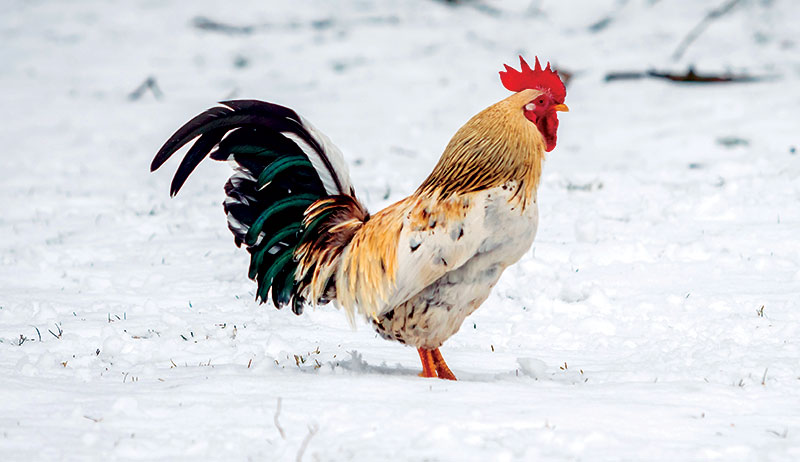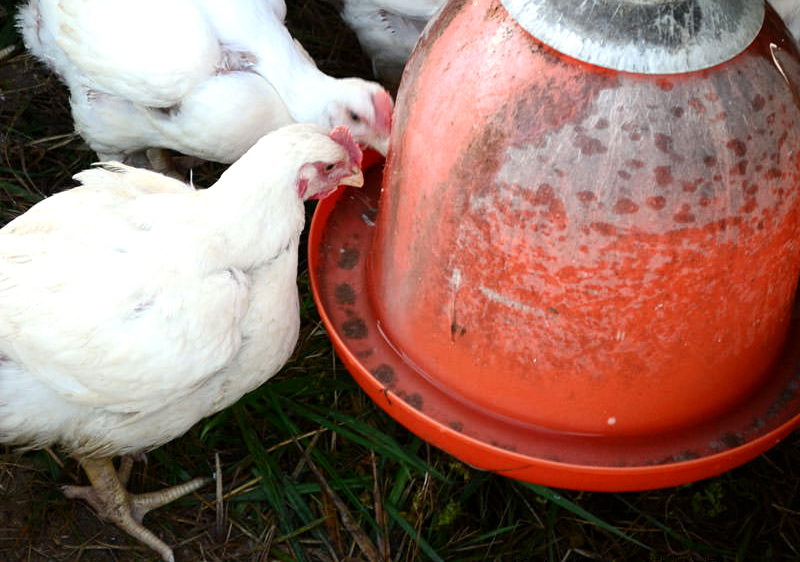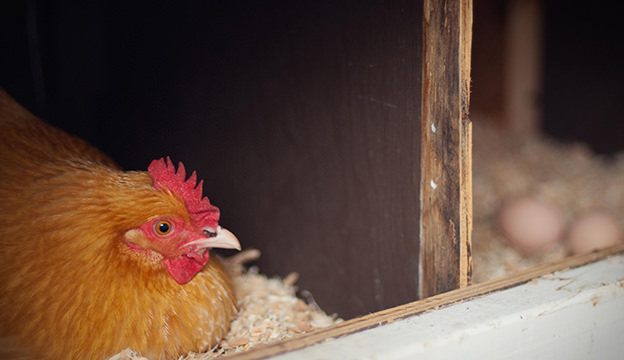
Chickens can withstand surprisingly cold winter temperatures if they have appropriate shelter and their environment is managed properly. But chicken keepers sometimes mistakenly believe that it’s a good idea to close up the coop and add heat in winter. Both of these practices are generally bad because they can create health problems as well as the risk of a coop fire.
By understanding how chickens combat cold and following the practices outlined in this article, you can, however, keep your flock naturally warm and happy throughout the winter months.

How Chickens Stay Warm
Chickens in cold weather stay warm by fluffing up their feathers. This creates tiny air pockets beneath their feathers that are warmed by the chicken’s body heat. The more air a chicken can trap and warm with its feathers, the warmer it will stay. Chicken feet are featherless, so birds often stand on one foot while tucking the other up into their feathers to warm it up. They also tuck their heads under a wing when sleeping to keep heads warm and protect combs and wattles from frostbite.
Chickens handle cold weather much better than they do hot weather. There are many successful chicken-keepers with unheated coops in colder regions such as Alaska and Canada. A heated coop is unnecessary unless the chickens are very young (featherless), aren’t a cold-hardy breed, are molting or sick, or temperatures suddenly drop drastically.
Because coops are usually wooden and chicken bedding is highly flammable, avoid adding heat via a heat lamp or other potential fire source when caring for chickens in cold weather. More chickens perish yearly from coop fires than from exposure to cold. Therefore, in cold winter areas, it’s better to choose cold-hardy breeds, raise chicks in warm weather and handle any molting or sick chickens on an individual basis.
Maat van Uitert is the founder of the blog Pampered Chicken Mama and owner of Living The Good Life with Backyard Chickens store. “If it’s very cold and we have a hen that’s going through a hard molt, we’ll bring her indoors in a dog crate so she won’t be cold at night,” van Uitert says. “Once her feathers have grown back or the temperature rises, we’ll put her back outdoors with her flock mates. The chickens remember each other, so it’s not a problem reintroducing the newly feathered hen”.
Feed Them for Winter
Chickens need to eat more in winter to generate body heat to stay warm. Also, during winter confinement, free-ranging flocks need extra feed to replace the food they would normally find by foraging. Chickens will eat 25 to 50 percent more in winter than what they consume in summer. So during winter, leave feed out all day allowing them to eat whenever they like. It’s also beneficial to modify their diet slightly to increase the amount of protein and fat they consume.
“To keep chickens comfortable over winter, we rely on a high protein diet with extra fat,” van Uitert says. “In addition to their regular feed, try offering dried insects that are high in protein and fat, such as mealworms or black soldier fly larvae. Lots of protein also helps with feather growth, which ensures your hens have healthy plumage to keep them warm. For extra fat on cold nights, you can add a bit of olive oil or peanut oil to their feed.”
Scratch Grains

Chickens love scratch grains, but these grains contain a lot of carbohydrates so it’s generally recommended that they be fed in moderation. That’s because the scratch dilutes the nutritional value of a balanced feed ration. However, in winter, the higher fat content of scratch can be beneficial.
Throwing your birds a few handfuls of scratch grain about 30 minutes before bedtime in the winter promotes warmth throughout the night. The increased carbohydrates help chickens in cold weather generate heat. If you feed them scratch grains in the coop, they also turn over the bedding making it easier to manage the deep litter method.
Ventilation
Chickens need a secure, draft-free coop to protect them from cold, snowy weather, so it might seem right to close the chicken coop in winter to keep the chickens warm. However, it’s extremely important to promote good ventilation. Chickens can handle colder temperatures as long as the environment is dry. They don’t sweat but instead exhale tremendous amounts of water vapor when they breathe. This leads to a buildup of humidity and ammonia fumes in a closed coop, which can cause frostbite on the chickens’ feet, wattles and combs as well as serious respiratory issues. If condensation forms on coop windows or you can smell ammonia, then the coop ventilation needs to be increased.
Ventilation sources should be placed high above the chickens roosting areas so that humidity and fumes are readily removed but the chickens are not exposed to any drafts. Open vents (covered with hardware cloth to prevent unwanted visitors) under the coop eaves keep air circulating but prevent drafts. To prevent drafts in lower areas, stack straw bales on the interior (if there is room) or exterior of the coop on the sides facing the prevailing winds. In addition to reducing drafts, this helps insulate the coop.
Edible Entertainment
Hanging vegetables such as cabbage, pumpkins or squash in the coop or run for the chickens to peck at is another way to encourage exercise. You can also string fruits and vegetables such as radishes, cranberries, grapes or carrot pieces on twine to hang in the coop or run for edible garlands. The fruits and vegetables provide entertainment, and your chickens appreciate something fresh in their winter diet.
Fresh Water

It can be a chore to ensure that your chickens have continuous access to fresh, unfrozen water in winter, but it’s critical for keeping them warm and healthy. They don’t drink as much water in the winter as they do in summer, but it’s still essential that they have it. Chickens can’t process their food, generate heat, make eggs or grow feathers without water.
For coops or runs without electricity, check the chicken waterers several times daily to make sure they’re full of water and that the water is not frozen. Chicken beaks are not strong enough to break even a relatively thin layer of ice, so it’s up to you to break and remove any ice buildup. If electricity is available or an extension cord can be run, several heated chicken waterers or pet bowls are available that prevent water from freezing. When purchasing a heated bowl or waterer, look for a model with an antichew cord to prevent your chickens from pecking through it.
Provide Appropriate Roosts
At night, chickens fluff up their feathers, hunch down over their feet and roost together to stay warm. For them to do this most efficiently, they need roosts that are properly sized. The roosting area should be large enough so that all the chickens can find a spot to sit next to each other. By snuggling together, they reduce the amount of their body that gets exposed to cold air and instead borrow their neighbors’ warm air.
Wide roosts are beneficial because they allow chickens to keep their feet tucked under their feathers all night to stay warm. Roosts should be wide enough so that chickens’ feet are completely covered by their feathers on top and the roosting surface on the bottom; 2-by-4-inch boards placed so that the 4-inch width accommodates their feet are ideal because the boards are wide enough that their toes don’t hang over the edges and get cold during the night.
Choose & Manage Bedding for Warmth

Many materials are commonly used for bedding in chicken coops; however; straw is generally the best bedding to provide warmth in cold winter areas. That’s because the hollow straw stems hold warm air from the day and continue to emit heat throughout the night.
In addition to using straw as the bedding material, using the deep-litter method for managing coop bedding promotes warmth.
To do this, start with a 6-inch layer of pine shavings on the clean coop floor, add a thin layer of straw daily, turn over the soiled bedding regularly and allow this mixture to decompose in the coop. It’s essentially a compost pile in the chicken coop. Studies show that the composting material generates heat and also produces beneficial microbes that help keep chickens healthy.
Because straw is added to the coop daily, the litter in the coop becomes deeper as winter goes on, hence its name the deep-litter method. This deep layer not only generates heat itself, but it also insulates the coop from the cold ground below. Once spring arrives, all the litter is removed, the chicken coop is cleaned and the process can be repeated.
Healthy Winter Treat : Suet Cakes
Feeding your flock appropriate treats during cold weather helps them generate heat and relieve boredom caused by winter confinement. The following treats are healthy for chickens during the winter:
Placing a suet feeder in the coop and feeding suet offers a treat that provides chickens with extra protein and fat. Suet cakes are available commercially, or you can make homemade suet using the following recipe.
Ingredients
- 1 cup natural crunchy peanut butter
- 2 cups “quick cook” oatmeal
- 2 cups cornmeal
- 1 1/2 cups lard
- 1 cup white flour
- 1/3 cup sugar
Preparation
Melt the peanut butter and lard together in a pan over low heat, then mix in the remaining ingredients (while still on low heat). Press the mixture into a square or rectangular cake pan so that the mix is about 1-inch thick (or the thickness of your suet feeder). Freeze for an hour, and then cut into squares that fit in your feeder. Store extra suet squares in the freezer (separated by wax paper) until ready to use.

It’s relatively easy to help flocks combat cold and stay happy in winter once you understand the basics about how chickens stay warm. By ensuring that the flock is properly fed, the coop is well-ventilated but draft-free, roosts are configured properly, fresh water is available and coop bedding is managed appropriately, you can keep your flock warm and healthy throughout the winter months.
This story originally appeared in the November/December 2018 issue of Chickens magazine.




